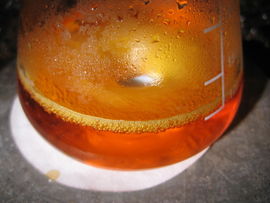Sodium dichromate
 Solution of sodium dichromate in water
| |
| Names | |
|---|---|
| IUPAC name
Sodium dichromate
| |
| Systematic IUPAC name
Bichromate of soda Celcure Chromic acid disodium salt Disodium dichromate Natriumdichromat | |
| Properties | |
| Na2Cr2O7 (anhydrous) Na2Cr2O7· 2H2O | |
| Molar mass | 261.97 g/mol (anhydrous) 298.00 g/mol (dihydrate) |
| Appearance | Dark orange solid |
| Odor | Odorless |
| Density | 2.52 g/cm3 |
| Melting point | 356.7 °C (674.1 °F; 629.8 K) |
| Boiling point | 400 °C (752 °F; 673 K) Decomposes |
| 73 g/100 ml (25 °C) | |
| Solubility | Soluble in ethanol, methanol |
| Solubility in methanol | 51.32 g/100 ml (19.4 °C) |
| Hazards | |
| Safety data sheet | Sigma-Aldrich (dihydrate) |
| Related compounds | |
| Related compounds
|
Potassium dichromate Ammonium dichromate |
| Except where otherwise noted, data are given for materials in their standard state (at 25 °C [77 °F], 100 kPa). | |
| Infobox references | |
Sodium dichromate is the inorganic compound with the formula Na2Cr2O7, commonly encountered as dihydrate.
Contents
Properties
Chemical
Sodium dichromate can be used along with sulfuric acid in the Jones oxidation to oxidize primary alcohols to aldehydes, and secondary alcohols to ketones.
Physical
Sodium dichromate is an orange solid, hygroscopic and soluble in water and alcohols.
Availability
Chemical suppliers generally have it in their stock, at various purities.
Preparation
Sodium dichromate can be produced from stainless steel from dinnerware or cooking implements, which contains a minimum of 10.5% chromium by mass. First, the entire piece of stainless steel is dissolved in conc. hydrochloric acid. The resulting solution should be dark green due to the chromium(III) ion. Sodium carbonate (not sodium hydroxide) is added to the solution to neutralize all remaining acids and precipitate a mixture of iron and chromium hydroxides, which are then filtered and washed. The washed mixture is mixed with sodium hypochlorite solution, which will oxidize the chromium(III) ions to chromate(CrO42-) ions, bringing them into solution as sodium chromate. Once the yellow filtrate is collected, a strong acid can be added to reduce the pH of the solution, producing a solution of sodium dichromate.
Another route involves melting a mixture of sodium hydroxide with chromium(III) oxide, with sodium nitrate.
Projects
- Make chromic acid
- Make flash powder
- Make potassium chromate
- Make chromium trioxide
- Make ammonium dichromate
Handling
Safety
Sodium dichromate, like all other hexavalent chromium compounds, is highly toxic and carcinogenic on ingestion or inhalation. Handling it can cause dermatitis, and it could also be absorbed through the skin in small amounts, usually if wet. Always wear gloves and goggles when handling it, and a dust mask or respirator when handling it as a powder to avoid inhalation of it, which could be fatal.
Storage
Sodium dichromate should be kept in plastic containers, with a proper label and a hazard symbol. While glass containers can be used, it's recommended to avoid them, as if you drop the bottle on the floor, it will shatter and the dichromate will spread all over the lab floor, which required decontamination.
Disposal
Sodium dichromate can be reduced with ascorbic acid to the less harmful chromium(III). Other reducing agents, such as sodium/potassium/ammonium sulfite/thiosulfate/metabisulfite can be used.